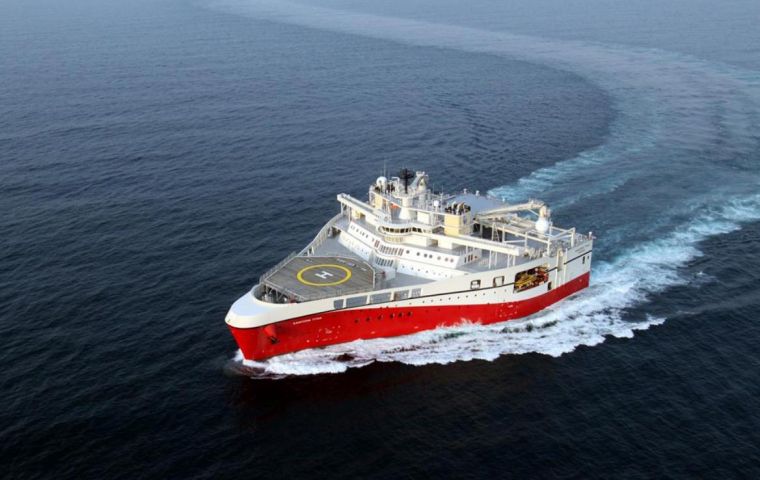MercoPress. South Atlantic News Agency
Falklands 2014 oil industry major focus: how to develop the Sea Lion discovery
 Major activity in 2013 has been completion of two 3D seismic campaigns in the South Falkland Basin with PGS Ramform Titan
Major activity in 2013 has been completion of two 3D seismic campaigns in the South Falkland Basin with PGS Ramform Titan After a busy 2011 and 2012, 2013 was a relatively quiet year for exploration around the Falkland Islands in the South Atlantic Ocean. The various companies involved in the region's nascent oil and gas industry preferred to spend the year focusing on seismic data acquisition campaigns and consolidating some of their assets.
The big news to come out of the Falklands in recent years was Rockhopper Exploration's discovery of up to 1.4 billion barrels of oil in its Sea Lion prospect in the North Falkland Basin during the spring of 2011.
But 2012 proved more disappointing in terms of exploration drilling. None of the wells drilled by Falkland Oil and Gas Ltd. (FOGL) and Borders & Southern Petroleum plc in the South Falkland Basin during 2012 found commercial oil, although Borders' Darwin well did yield an estimated 190 million barrels of condensate.
The major activity in 2013 has been the completion of two 3D seismic campaigns in the South Falkland Basin and the start of a third. FOGL and Desire Petroleum plc decided to merge, which has resulted in an enlarged company that has a war chest for exploration activities that amounts to 275 million dollars.
The major focus of attention during 2014 will be on the Sea Lion discovery in the North Falkland Basin. Specifically, observers of the Sea Lion project are expecting the imminent arrival of details about how the project's partners plan to develop the field.
Project sanction for Sea Lion is expected by the end of the year, according to operator Premier Oil plc and partner (and field discoverer) Rockhopper Exploration plc. The field is estimated to hold 394 million barrels of oil equivalent that can be recovered. Once developed it is expected to reach a gross production plateau rate of between 80,000 and 85,000 barrels per day, although first oil is unlikely to be achieved until late 2018 at the earliest.
Premier holds a 60-percent interest in the PL032 license, which contains the majority of the Sea Lion discovery, after it farmed into the field in October 2012. Rockhopper retains the remaining 40-percent stake.
But Premier and Rockhopper are not the only companies keeping a close eye on the Sea Lion project. This is because the field extends south into the PL04b license, in which Falkland Oil & Gas holds a 40-percent stake along with Rockhopper (which holds 24 percent) and Premier (36 percent).
Any development here would likely not begin until the next decade, with first production being not earlier than 2022, according to analysts at New York-based investment bank Jefferies. Estimates for the PL04b license range from 71 million barrels to 218 million barrels.
Recent farm-in deals, along with FOGL's takeover of Desire Petroleum, have seen the three companies achieve the same ownership structure over the nearby PL004c blocks. Rockhopper Exploration reported Dec. 9 that it now owned 24% of these licenses, while Premier (the operator) and FOGL holding 36% and 40% respectively.
Here, Premier and Rockhopper have agreed to fund FOGL's share of the cost of two exploration wells – one on each license – with drilling on the Isobel/Elaine and Jayne prospects expected as soon as late 2014.
Meanwhile, in the South and East of the Falkland Islands, the PGS Ramform Titan survey vessel is currently conducting a 3D seismic survey for Noble Energy Inc. over a mid-Cretaceous Herisilia fan complex. The survey is expected to be completed by the end of the first quarter of 2014.
FOGL reported near the start of November that “fast-track data” from two 3D seismic surveys already completed in 2013 have been received and that interpretation of this data is ongoing. Preliminary work on the data has already identified a number of large prospects within the Diomedia fan complex, while new data is also enhancing the firm's understanding of potential prospects with the Fault Block area, adjacent to the Darwin discovery.
By Jon Mainwaring, Rigzone Staff




Top Comments
Disclaimer & comment rules-

-

-

Read all commentsSo it is expected to produce the equivalent of 25 barrels per day per Islander for a period of 14 years.
Jan 02nd, 2014 - 06:53 pm 0@1 Current crude price = roughly US$98/barrel.
Jan 02nd, 2014 - 07:34 pm 098 x 25 = US$2450/islander/day.
2450 x 365 = US$894,250/islander/year
894,250 x 14 = US$12,519,500/islander over 14 years.
If I were an Islander, I'd take that.
I think you will find that the oil companies extracting the oil would possibly get a20% of the oil recovered, after all they are the ones investing, but nevertheless the Islanders are on to a sure thing.
Jan 02nd, 2014 - 08:37 pm 0Commenting for this story is now closed.
If you have a Facebook account, become a fan and comment on our Facebook Page!